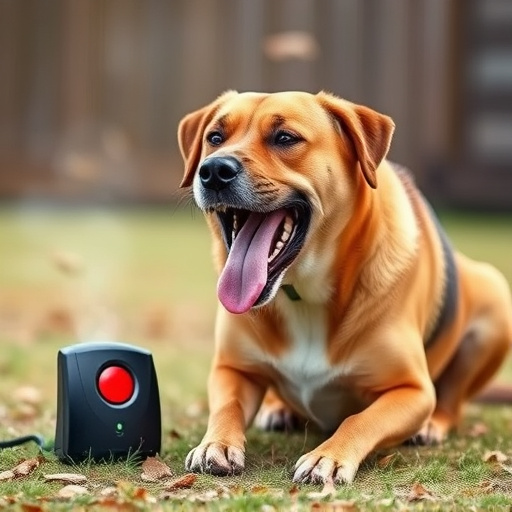A Stationary vs Mobile Dog Repellent Comparison reveals distinct pros and cons of each type. Stationary devices, effective for specific areas, rely on scent or sound barriers but may struggle in high-traffic zones or against multiple dogs. Mobile options, like ultrasonic devices, offer flexibility for temporary or varied dog activity but require maintenance and can be affected by weather. The choice depends on owner needs, dog behavior, and environment, with mobile devices ideal for outdoor activities, public spaces, and indoor training sessions due to their portability and strategic placement capabilities.
“Unleash your peace of mind with a dog defense ultrasonic portable device, a revolutionary tool for pet owners. This article provides an in-depth look at these innovative solutions, demystifying their functionality and exploring two primary categories: stationary and mobile repellent devices. We’ll delve into how each type utilizes ultrasonic technology to deter canine intruders, offering a comprehensive Stationary Vs Mobile Dog Repellent Comparison. By the end, you’ll be equipped with knowledge to choose the best defense for your space.”
- Understanding Dog Defense Ultrasonic Devices: How They Work
- Stationary Dog Repellents: Pros and Cons
- Mobile Dog Repellent Devices: Advantages and Applications
Understanding Dog Defense Ultrasonic Devices: How They Work
Dog defense ultrasonic devices have gained popularity as a non-lethal way to deter aggressive canine behavior. These innovative tools emit high-frequency sound waves that are inaudible to humans but can be unpleasant for dogs, encouraging them to back away. At their core, they offer a safe and effective alternative to traditional repellents or physical confrontation.
When it comes to dog defense ultrasonic devices, there’s a fundamental distinction between stationary and mobile options. Stationary units are typically installed in specific areas like yards or doorways, emitting sounds when triggered by the dog’s proximity. In contrast, mobile devices are portable, allowing users to carry them during walks or outdoor activities. A mobile vs. stationary comparison reveals that while both have their merits, mobile options provide greater flexibility and versatility for managing dog interactions in various settings.
Stationary Dog Repellents: Pros and Cons
Stationary dog repellents are designed to keep canines away from specific areas, typically using scent or sound deterrents. They are often installed in yards or outdoor spaces as a long-term solution to prevent unwanted dog visits. The primary advantage is their consistency; they provide a reliable and continuous barrier, ensuring peace of mind for pet owners. However, one significant drawback is that they might not be as effective in areas with frequent foot traffic or when multiple dogs are involved, as the scent or sound can diminish over time or be overshadowed by other stimuli.
In contrast, mobile dog repellents, like ultrasonic devices, offer a more versatile approach. These portable tools emit high-frequency sounds that are unpleasant to dogs, encouraging them to stay away. The main pro is their adaptability; they can be easily moved and placed in various locations, making them ideal for temporary solutions or areas with fluctuating dog activity. Yet, the downside is that they may require frequent recharging or battery replacement, and their effectiveness can be compromised by wind or rain, as the ultrasonic waves can be dispersed.
Mobile Dog Repellent Devices: Advantages and Applications
Mobile Dog Repellent Devices offer a convenient and effective solution for managing canine behavior in various settings, providing an alternative to traditional stationary deterrents. Unlike fixed barriers or signs, these portable tools can be easily transported and deployed in different locations, making them ideal for outdoor activities, public spaces, and even indoor training sessions. One significant advantage is their flexibility; users can strategically place the devices where needed, ensuring a more controlled environment.
In terms of advantages over stationary repellents, mobile dog deterrents are particularly useful for temporary events or areas with frequent changes in layout. For instance, they can be quickly set up at parks, outdoor markets, or during community gatherings to keep dogs under control without causing discomfort or restricting access as fixed barriers might. This comparison highlights the versatility of mobile devices, offering a practical approach to managing dog interactions while maintaining a balance between safety and freedom in various environments.
In comparing stationary and mobile dog repellent devices, each offers unique advantages. Stationary units are ideal for establishing a consistent barrier in fixed locations like yards or patios, while mobile devices provide flexibility for those who need to repel dogs during travel or in various environments. When choosing between them, consider your specific needs, the size of the area to be protected, and whether portability is a key factor. Ultimately, both options can effectively help protect spaces from unwanted dog interactions, ensuring peace of mind for pet owners and dog enthusiasts alike.
